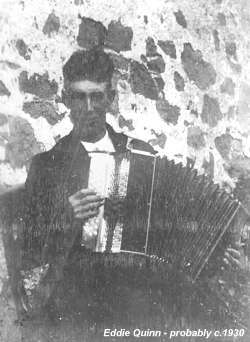 Today, several people in the Selkirk area recall that their grandparents and great-grandparents would meet for informal dances in quiet country lanes on a Saturday night, and that the music would be provided by a fiddle or melodeon player.
Today, several people in the Selkirk area recall that their grandparents and great-grandparents would meet for informal dances in quiet country lanes on a Saturday night, and that the music would be provided by a fiddle or melodeon player.
It is said that in the 1840's, at the time of the Irish potato famine, up to 1,000 Irish people were arriving weekly in Glasgow. Many of these people were agricultural workers and by the end of the 1800's there was a high percentage of Irish born workers scattered throughout Scotland, especially in the Border Regions to the south and south-east of Glasgow. One such Irishman, was Edward Quinn (1846 - 1926), the son of Charles Quinn, a blacksmith who died sometime prior to 1878, and Margaret Quinn, nee Boyl [sic], who was born in Tyrone in the early 1800s. On 2nd September, 1878, at Bridge End, Dunse (now Duns), Edward married a 20 year old domestic servant called Margaret Blackie.
Margaret's parents, William and Margaret, had also worked in domestic service, William, born in 1836, being a coachman. His wife, Margaret, who was born Margaret Paterson, was also born in the same year as her husband, but had died prior to her daughter's wedding. There is a suggestion that the couple had once worked at Marshall Meadows, just over the English border about three miles to the north of Berwick-upon-Tweed.
Twenty years after her marriage, Margaret Quinn gave birth to her eighth, and final, child at 10am on 17th December, 1898. The child, named Edward after his father, was born at The Shiels Farm in the Berwickshire Parish of Ladykirk. 1 Ladykirk was originally known as Upsettington, but the Scottish King, James IV, is believed to have changed the name when he built a church there in gratitude to Our Lady, after he almost drowned nearby in the River Tweed in 1499. St Mary's Church, built c.1500, stands today on the raised north bank of the Tweed, overlooking the ancient Northumbrian village of Norham, and can be seen from miles around.
According to family tradition, young Eddie was to become the only musician in the family and was able to play the two row melodeon (or button accordion, as it is called locally) when only four or five years old. It is also said that in his youth he would play the accordion whilst lying on his back in front of the fire. We do not know if any one person taught Eddie, only that he 'picked it up by ear', although we do know that he was unable to sight-read music. Eddie's early repertoire was certainly set well within the local Scottish tradition and so it seems unlikely that it was his Irish father who first taught him to play. The button accordion had become a highly popular instrument by the beginning of the twentieth century. According to Stuart Eydmann in his article As Common as Blackberries: the First Hundred Years of the Accordion in Scotland, 1830 -1930, 'That the accordion has a special position in popular and traditional music making in Scotland is beyond question.' 2 It may, therefore, be speculated that the young Eddie heard accordions being played by some of the local farm workers and it was from them that he first learnt to play.  Today, several people in the Selkirk area recall that their grandparents and great-grandparents would meet for informal dances in quiet country lanes on a Saturday night, and that the music would be provided by a fiddle or melodeon player.
Today, several people in the Selkirk area recall that their grandparents and great-grandparents would meet for informal dances in quiet country lanes on a Saturday night, and that the music would be provided by a fiddle or melodeon player.
Eddie followed in his father's footsteps and became a farm worker himself, his first job being on a farm at Lumsden, near Coldingham. Eddie worked as a horse driver until the horses were replaced by tractors, which he soon learnt to handle, and, apparently, became known locally as 'The Kelsie plooman'. On 29th August, 1925 Eddie, who was then working on a farm at Hadden, near Windywalls, married Mary Black, also from Windywalls, at St Mary's Roman Catholic Church in Kelso, the banns having been read at their local parish church of Sprouston. Sometime around 1934 Eddie moved to the Buccleuch Estate at Carterhaugh, between Selkirk and the Yarrow Valley. Carterhaugh is, of course, the home of the ballad hero Tam Lin.
O I forbid you, maidens a',Adam Boyd (b.1918) was fifteen years old when he first heard Eddie play for a dance in Sprouston school hall. At the time Eddie was playing with Will Telford, a farm worker from the Kelso area who played the fiddle, and a young drummer called Bobby Tuck, who died at an early age.
That wear gowd on your hair;
To come or gae by Carterhaugh,
For young Tam Lin is there.
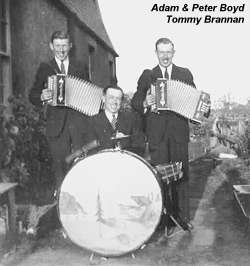 Adam and his brother Peter had learnt to play the button accordion from their father, John Boyd - who also played the fiddle and the pipes - a farm worker from Spylaw, on the Kelso/Yetholm road. When Eddie left Hadden, Adam and Peter joined up with a drummer, Tommy Brannan from Kelso, and formed a band to fill the gap left by Eddie. Peter Boyd, who was older than his brother, had previously played with another button accordion player, Jock Liddle, a gardener from the Hirsel Estate at Coldstream, who had occasionally played with Eddie Quinn. 3
Adam and his brother Peter had learnt to play the button accordion from their father, John Boyd - who also played the fiddle and the pipes - a farm worker from Spylaw, on the Kelso/Yetholm road. When Eddie left Hadden, Adam and Peter joined up with a drummer, Tommy Brannan from Kelso, and formed a band to fill the gap left by Eddie. Peter Boyd, who was older than his brother, had previously played with another button accordion player, Jock Liddle, a gardener from the Hirsel Estate at Coldstream, who had occasionally played with Eddie Quinn. 3
By the time Eddie moved to Carterhaugh he must have become well-known as a musician - having, by then, recorded two 78 gramophone records. Although some locals believed that these were recorded in Kirkaldy, Fife, Eddie's daughter Betty, who was then aged about 5 years old, can just remember her father travelling by train to London to make the records. 4 Eddie's recordings are characterised by a lightness of touch, his fingering supple and delicate, and it may well be that they represent a local style of playing that was soon to disappear when 78rpm records and the wireless began to create an overall 'Scottish' dance-band sound. 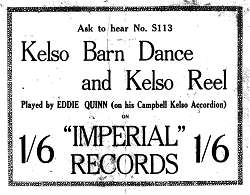 Very few, if any, other Kelso musicians were recorded in this period and Eddie's records could well be the only ones made which preserved this style of playing.
Very few, if any, other Kelso musicians were recorded in this period and Eddie's records could well be the only ones made which preserved this style of playing.
One recording - Kelso Barn Dance / Kelso Reel - was recorded in late December, 1929, and issued on the Imperial label (Imperial S113). Kelso Barn Dance is, in fact, the pipe tune Inverness Gathering, while Kelso Reel is a version of the well-known De'il Amang the Tailors. The other recording - The Gay Gordons / The Laird o' Drumblair - was issued on the Beka label (Beka 3005/06), although it seems that the recordings were originally made by the Parlophone company. If so, then the matrix numbers indicate that these recordings would have been made in early January, ![]() 1930, and it is likely that Eddie recorded both of his records during the same visit to London.
1930, and it is likely that Eddie recorded both of his records during the same visit to London. ![]() The Gay Gordons (sound clip, left) is another pipe tune, while The Laird o' Drumblair (sound clip, right) is a composition by the well-known Scottish fiddler, James Scott Skinner. Eddie is accompanied on all four sides by an unknown piano player, as was then customary, and on each side he continues to play the named tune repeatedly from start to finish, unlike other performers who would play a selection of two or three tunes per side. Will Telford thought that the reason why Eddie only made two records was because the public preferred to hear a medley of tunes on each side of the record and this may well be why Eddie was not invited back to London. There is another possibility. Eddie was sponsored as a musician by an Algie Campbell who ran a music shop in Woodmarket in Kelso. Somewhere along the line the pair fell out and if, as seems likely, Campbell secured the recording sessions for Eddie, then it may have been that the recording companies were unable to contact Eddie directly in order to arrange further sessions. There is also the possibility that the two record companies were unhappy that Eddie had recorded for a rival company. Whatever the reason, it is a great pity that Eddie made only two records,
The Gay Gordons (sound clip, left) is another pipe tune, while The Laird o' Drumblair (sound clip, right) is a composition by the well-known Scottish fiddler, James Scott Skinner. Eddie is accompanied on all four sides by an unknown piano player, as was then customary, and on each side he continues to play the named tune repeatedly from start to finish, unlike other performers who would play a selection of two or three tunes per side. Will Telford thought that the reason why Eddie only made two records was because the public preferred to hear a medley of tunes on each side of the record and this may well be why Eddie was not invited back to London. There is another possibility. Eddie was sponsored as a musician by an Algie Campbell who ran a music shop in Woodmarket in Kelso. Somewhere along the line the pair fell out and if, as seems likely, Campbell secured the recording sessions for Eddie, then it may have been that the recording companies were unable to contact Eddie directly in order to arrange further sessions. There is also the possibility that the two record companies were unhappy that Eddie had recorded for a rival company. Whatever the reason, it is a great pity that Eddie made only two records, 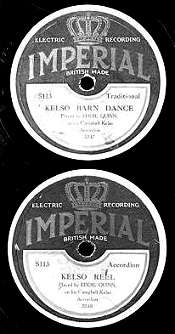 for his playing was of the highest quality and he was clearly an outstanding musician. "He was a master of timing - very constant - and that's what made him so good for dancing", said the pianist Billy Douglas (b.1926).
for his playing was of the highest quality and he was clearly an outstanding musician. "He was a master of timing - very constant - and that's what made him so good for dancing", said the pianist Billy Douglas (b.1926).
Many of the people that I have spoken to were surprised to be told that Eddie had made two records, most believing that he had only made one, and it may be that the record produced by Beka was not issued in Britain, but was only issued abroad.
It seems strange that Eddie's family now know little about their father's recording sessions. The only thing to be remembered was the fact that Eddie mentioned a red light in the studio and that he had to start playing when the light came on, and had to stop when the light went out. Adam Boyd believes that Eddie was accompanied to London by Algie Campbell (a fact confirmed by Eddie's daughter, Betty) and says that when Eddie entered the studio he was somewhat flustered when the pianist asked Eddie for his sheet music!
On both records Eddie is described as playing a 'Campbell Kelso Accordion'. This is probably a reference to Algie Campbell's shop, Campbell having ordered a custom batch of accordions from an established manufacturer, or there is the less likely possibility that Eddie was playing an instrument manufactured by Campbell & Co of Glasgow. In the photograph taken c.1947 (below) Eddie can be seen playing a Paolo Soprano three-row button accordion.
After he made his two records, Eddie began to play with one or two other local musicians, including Will Telford and a drummer by the name of Sandy Cairns, who lodged with Eddie and his family. "I'm awa' tae the kirns", is how Eddie expressed himself in those days. Kerns being a local Berwickshire term for a barndance. Elsewhere in Scotland the term is used to mean a harvest supper and dance organised, and paid for, by a farmer.
By the mid '30s Eddie had formed a band which played together for about fifteen years. The band was certainly in existence in 1936 when they played for the first Kelso 'Laddies Week'. To begin with, Eddie would travel to dances on a bicycle, his accordion strapped across his back. Later, they travelled in two cars which frequently broke down. As the band's popularity grew, many of their Selkirk supporters would follow them to dances elsewhere, and up to three 35 seat charabancs had to be hired to carry them to the dances. During the war years Sandy Cairns, who by that time had become the band's MC, was able to get extra petrol coupons because the band played for Army dances. Tommy Heard (b.1929), who joined the band as drummer in 1942 when he was thirteen years old, remembers Eddie sitting in Sandy's cars saying, "Cairns - keep her on the metal, Sandy!" Tommy first met Eddie when the latter would call to see his father, John Heard, who played the fiddle. 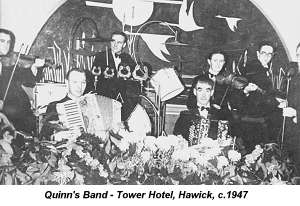 The two would play together at the Heard home in Philiphaugh and the young Tommy would try to 'accompany' them by beating two knitting needles on their instrument cases. Eddie encouraged Tommy and, before long, had the youngster playing in his band.
The two would play together at the Heard home in Philiphaugh and the young Tommy would try to 'accompany' them by beating two knitting needles on their instrument cases. Eddie encouraged Tommy and, before long, had the youngster playing in his band.
In the late 1940s 'Quinn's Band', as it was then known, comprised: Jock Elliot (piano accordion), who worked in the timber trade; Ernie Lamza (piano accordion) a Polish born mill worker; James Hardie (fiddle), a farmer from St Boswells; Billy Douglas (piano), a joiner from Selkirk; Tommy Heard (drums) a gamekeeper from Bowhill; and, of course, Eddie playing the three-row accordion. Other occasional players would include: Tom Rutherford (2nd fiddle); Andrew Temple (drums), a cabinet maker from Selkirk who sat in for Tommy Heard while Tommy was away doing National Service in the RAF as a bandsman; Walter Bateman (drums), a painter from Selkirk; and Andrew Stillie, yet another drummer from Selkirk. On average the band needed about six or seven musicians. These were the days before amplification and this number of musicians was needed to make themselves heard above the sound of the dancing. One thing that distinguished the band from others was the fact that Ernie Lamza would sometimes leave the bandstand during a dance and walk between the dancers, playing to each couple in turn.
The band played for dances throughout the Borders and Eddie's son Ronnie remembers them playing in such towns and villages as Etterick Bridge, Yarrow Ford, Kelso, Eccles, Hawick, Greenlaw, Duns, Coldstream, Bergham, Gordon, Selkirk, Denholm, Bonchester Bridge and across the border in the Cheviot market town of Wooler. 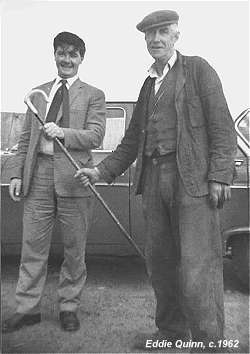 Tommy Heard remembers playing in most of these places, as well as Langholm, Swinton, Morebattle, Lilliesleaf, the Boston Hall near Tushielaw, Galashiels, Lindean, Cappercleuch, Peebles, Walkerburn, Clovenfords and Yetholm, although he cannot recall playing at any dances in Northumberland with Eddie's band. According to Billy Douglas they would play "Saturday after Saturday" at Lilliesleaf, at dances organised by the Selkirk Pigeon Club. On one occasion, the band travelled as far as the Isle of Skye, where they played for two or three days. Billy Douglas was aware that the dances differed - in steps and timing - in different parts of the Borders and that the band had to accommodate these differences in their playing.
Tommy Heard remembers playing in most of these places, as well as Langholm, Swinton, Morebattle, Lilliesleaf, the Boston Hall near Tushielaw, Galashiels, Lindean, Cappercleuch, Peebles, Walkerburn, Clovenfords and Yetholm, although he cannot recall playing at any dances in Northumberland with Eddie's band. According to Billy Douglas they would play "Saturday after Saturday" at Lilliesleaf, at dances organised by the Selkirk Pigeon Club. On one occasion, the band travelled as far as the Isle of Skye, where they played for two or three days. Billy Douglas was aware that the dances differed - in steps and timing - in different parts of the Borders and that the band had to accommodate these differences in their playing.
Borders, in this case between Scotland and England, may be viewed as barriers which separate people and traditions. But they can also be seen as places where different cultures converge and cross. Writing in the booklet notes that accompany the Topic CD Ranting and Reeling - Dance Music of the North of England, Reg Hall has this to say about the influence of Scottish musicians on the local Northumberland repertoire:
In the early post-War years the demand for dancing was such that a man called McKinnon began to book some of the big names in Scottish music from over the border for dance engagements. Bands like those of Bobby MacLeod, Jim Cameron, Smiling Jack Forsyth and Lindsay Ross and the Hawthorn Band played only the local repertory when they were in Northumberland - no Scottish country dances at all. Most of them, however, had difficulty playing the right time and rhythm, and it was the job of the local MC to put them right. The only one among them who had a natural feel for local style was Jimmy Shand who, it is reputed, got it right every time. Local musicians in the Cheviot Ranters, impressed by his tunes for the Student Lancers, picked them up bit by bit over the course of three or four of his bookings. The visitors from over the border created great interest among the Northumbrian musicians, and Will Atkinson, for one, believes they did nothing but good for the music. 5The man 'called McKinnon' was, in fact, Duncan McKinnon, a dance promoter from the Melrose area, who arranged a number of bookings for Eddie and the band. It is interesting to hear of Jimmy Shand playing in Northumberland. According to Ronnie, Shand met his father in 1947 when making his first visit to play in Selkirk's Victoria Hall. Shand was clearly aware of Eddie - probably through his recordings - and on that occasion called Eddie the "Button accordion champion of the Borders". High praise, indeed, from a man who was later to be knighted for his contribution to Scottish dance music and accordion playing.
Edgar Dixon, a button-accordion player who spent most of his working life on farms in the area around Lowick in north Northumberland, sees himself as "neither English, nor Scottish", but is, like many of his English neighbours, "a Borderer". Edgar's father, who was from the same area, played the fiddle and taught Edgar much of his early repertoire. Although Edgar was later heavily influenced by the music of Jimmy Shand, he believes that the 'Border's style' stretches from such Scottish towns as Selkirk and Kelso to as far south as Wooler, Alnwick and Rothbury. "Some places might have different steps - such as the 'Wooler hop' - but the tunes were no problem, wherever you played". Except, it seems, in one case. Edgar recalls that for the dance Drops of Brandy / Strip the Willow the Scottish musicians would play reels, whereas musicians in Northumberland or Cumbria would play hornpipes. There was also the occasional local dance - such as the Morpeth Rant or the Cumberland Square Eight - but, generally speaking, dances were the same on both sides of the borders. 6
About fifteen years ago Will Telford was asked what type of tunes he had played with Eddie. He replied "Old fashioned ones ... quadrilles, eightsome reels, lancers and waltzes". Will also described Eddie as being "a congenial man ... who tolerated no nonsense". 7 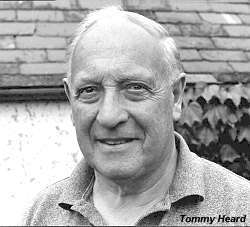 Tommy Heard said that Eddie was "a tall man with a high pitched voice, who was very jovial and popular and easy to get on with", while Billy Douglas felt that Eddie was "more similar in temperament to Jimmy Shand", an observation that other people have also made to me. 8
Tommy Heard said that Eddie was "a tall man with a high pitched voice, who was very jovial and popular and easy to get on with", while Billy Douglas felt that Eddie was "more similar in temperament to Jimmy Shand", an observation that other people have also made to me. 8
According to Tommy Heard, most of the band's bookings were in village halls, where the piano would often be wildly out of tune. Occasionally, perhaps once or twice a year, the band would be booked to play on more formal occasions, such as Hunt Balls or Works Balls. Here the band would start with the dance The Grand March, followed by the Eightsome Reel and The Duke of Perth. Often on these occasions the dancers would know very few dances and the band would have to play the same dances over and over. Tommy recalls having to play the Duke of Perth at least three times at one such dance. On these occasions the players would each be paid 17/6d; although their normal wage was 15/- for playing on a Friday night in a village hall and 10/- for playing on a Saturday night.
When asked to describe a typical sequence of dances that would be played in a village hall, Tommy said, "Old Time Waltz, St Bernard's Waltz, Old Gay Gordons, Military Two-Step, Eightsome Reel, Drops o' Brandy, The Student Lancers, Jack Tar Two-Step, a Quickstep and a Fox-trot". Surprisingly, the band never seemed to rehearse together, although Jock Elliot and Eddie would spend a lot of time practicing together in private. When a new tune was to be introduced, Billy Douglas would buy the sheet music, learn the tune, 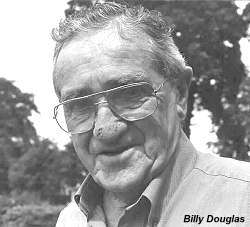 and then simply play it at a dance, the rest of the band following by ear until they had it memorized. Usually it took about two or three dances before all the members of the band had the tune firmly fixed in their heads.
and then simply play it at a dance, the rest of the band following by ear until they had it memorized. Usually it took about two or three dances before all the members of the band had the tune firmly fixed in their heads.
Billy Douglas said that the band would play three tunes for each dance. The tunes, however, were not played as a medley; rather the band would play the first tune for a few minutes and would then stop. The dancers would stay on the floor, and then begin dancing again when the band began to play the second tune. This tune would last for a few minutes until the band again stopped. Finally, the third tune would be played and, when completed, the couples would leave the dance floor. This was, of course, how Eddie recorded his four gramophone sides and may explain why he did not record a medley of tunes on each side. On the recordings Eddie was playing exactly the way that he normally played for dancers.
Often there would be a Waltz Competition during the dances and Tommy Heard remembers that the tune Rothesay Bay was used for this event. Billy Douglas, who continues to play the electronic keyboard today, remembers many of the tunes and offered the following tune titles for dances that he could remember: Old Time Waltz (Ho-Ro My Nutbrown Maiden / The Skye Boat Song / Cruising Down the River / Moonlight on the St Lawrence / Coming through the Rye). Quick-Step (Several 'Glenn Miller' tunes, such as In the Mood. Also Whispering / Darktown Strutter's Ball). Modern Waltz (Anniversary Waltz / Charmaine / I'll Be Your Sweetheart). Eightsome Reel (De'il Amang the Tailors / The Fairy Dance / Barren Rocks of Aden) - Billy and his wife call the tune Barren Rocks of Aden, 'We're All Awa ' tae the Tattie Fields' after the following verse which the band and dancers would sing during the dance:
We're all awa' tae the tattie fields,Spanish Waltz - danced by four couples in a square (The Mountains of Mourne). Gay Gordons (The Happy Wanderer / Scotland the Brave). Slow Fox-trot (The White Cliffs of Dover / Silver Wings in the Moonlight / Love Letters in the Sand). Highland Schottische (The Keel Row / Orange and Blue). Military Two-Step (Blaze Away / Washington Post). Drops o' Brandy (Muckin' o ' Geordie's Byre or any other 6/8 tune). Veleta Waltz (Believe Me all Those Endearing Young Charms). The Lancers - according to Billy, this was only occasionally played and the dance had it's own specific set of tunes.
Tae the tattie fields, tax the tattie fields.
We're all awa' tae the tattie fields.
To gaither in the tatties.
It will be immediately apparent that most of the tunes played in the '40s were modern pieces, far removed from those that Eddie recorded earlier on his 78's. Billy said that most of the dancers were young couples who were only happy if the band played the latest 'hits'. In a way, this reminds me of the comments made by the Norfolk singer Walter Pardon (1914 - 1996) who said that most of his generation ridiculed the singing of old songs, preferring, instead, the latest songs that they heard on the wireless.
Sandy Cairns also organized the 'Yarrow Ford Concert Party' which would sometimes accompany the band and would perform before the dance began. The Concert Party comprised about six or seven young girls, including Eddie's daughters Betty and Margaret, who would sing, dance and perform short comic sketches, and a pianist. Occasionally, Eddie would take over from the pianist. Jimmy Blake, a farm labourer who worked with Eddie, would sometimes join the Party to sing songs such as Red River Valley or Huntingtower.
Sometime around 1948 Eddie and the band travelled to Edinburgh to audition for a spot on the BBC radio programme 'Scottish Dance Music', a twice-weekly showcase of all that was best in local music. Sadly, they were turned down, a fact which seems to have deeply affected Eddie and his friends, and the band broke up in 1950. Eddie was not a member of the Musician's Union, and this may be why the BBC felt unable to employ the band.
Occasionally, Eddie would play for a dance with one or two other musicians, including Will Starr, another button accordion champion. 9 But his hands were becoming stiff and arthritic, following all his years of outdoor labouring. According to Stan Aird, another accordion player from Jedburgh, Eddie was still a 'marvellous player', even in his seventies, but he was aware that his fingers were not as supple as they used to be. Eddie would sometimes travel to Galashiels to play for a wedding and he was occasionally taken to a local accordion club which met at the Railway Inn at Newtown St Boswells. 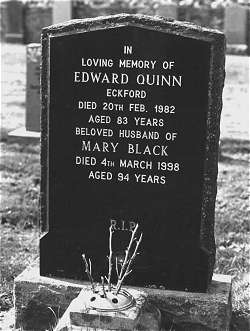 Here he played alongside other button accordion players such as Bobby Rae, who was from Ancrum, and Sandy Ramage, who may have been from Jedburgh, but it was clear by then that Eddie's playing days were more or less over. 10
Here he played alongside other button accordion players such as Bobby Rae, who was from Ancrum, and Sandy Ramage, who may have been from Jedburgh, but it was clear by then that Eddie's playing days were more or less over. 10
When he was 65 years old Eddie retired from work and settled with his wife in a Buccleuch Estates retirement cottage in the village of Eckford, just off the A698, between Kelso and Jedburgh. According to a neighbour, Doug Gotterson, Eddie would still play the accordion at home, and could play 'all night long without repeating a tune'. Gradually, though, his musical days came to an end and Eddie passed away on 20th February,1982. Had he made more records he would, I am sure, have become as famous as William Hannah or even Jimmy Shand for that matter. But that was not to be. At least now there is a face and a story to go with the name and, of course, there will always be that wonderful handful of unique recordings made by Eddie Quinn, the 'Button accordion champion of the Borders' .
December,1929 London
Imperial S113
5347 - Kelso Barn Dance
5348 - Kelso ReelJanuary,1930 London
Beka 3005/06
E 3005-1 - The Laird o' Drumblair - Country Dance
E 3006-1 - The Gay Gordons - Country Dance
Mike Yates - 7.7.00
Article MT056
| Top of page | Articles | Home Page | Reviews | News | Editorial | Map |